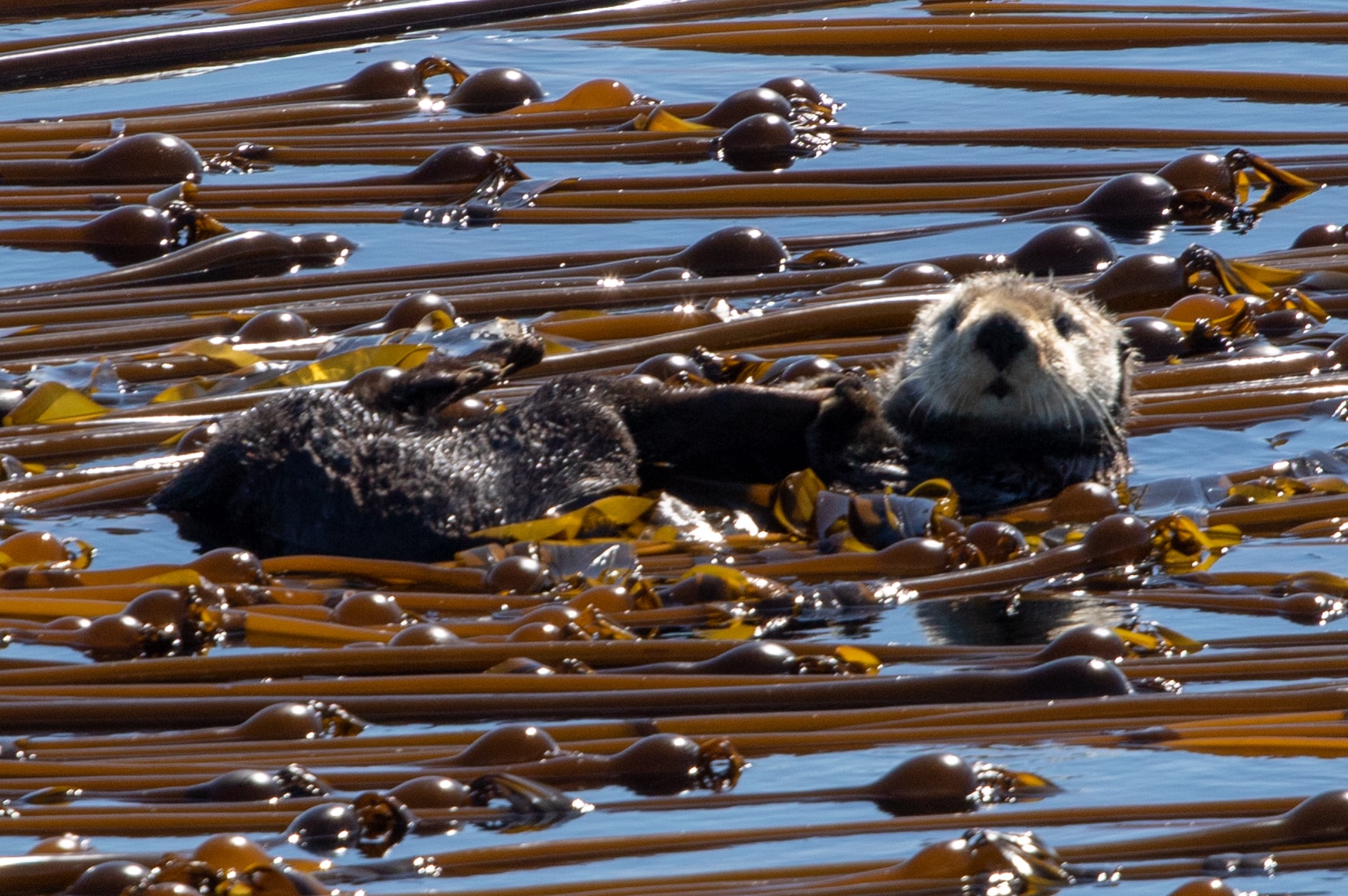Written by: Rachael Merrett- Orca Spirit Marine Naturalist
Most people swoon at the adorable faces of Sea Otters and their habit of holding each other’s paws to stay close together. Many people are unaware of the history of sea otters in the North Pacific and how close the world came to losing them completely.
Locally, we have one – that’s right – ONE Sea Otter that lives in the kelp beds of Race Rocks Lighthouse. The whale watching community affectionately calls him Ollie. We hope that Ollie is just the first of the Sea Otters that will move to local waters and once again call this place home.
Sea Otters are a keystone species of the kelp forest ecosystem. Without Sea Otters, kelp forests can be destroyed by sea urchins who graze on the kelp. Sea urchins happen to be a favourite food source for Sea Otters and they can eat a lot of them, thereby controlling the populations of sea urchins within a kelp forest. Kelp forests support a vast number of other species like crabs, fish, invertebrates, and even sea lions. When one species is removed, a cascade effect occurs, threatening the very existence of the ecosystem.
There are 3 Sub-species of Sea Otters:
- Southern Sea Otter- Exclusively found in Central California
- Northern Sea Otter- Range from Washington to Alaska
- Common/Asian Sea Otter- Found in the Commander Islands, the Kuril Islands of the Western Pacific and occasionally seen in the northernmost islands of Japan.
Despite have distinct genetics, the three sub-species have few physical differences between them.
Photos: Ollie the Sea Otter at Race Rocks Ecological Reserve. Photos taken by Rachael Merrett- Orca Spirit Marine Naturalist.
Fun Facts About Sea Otters!
- Sea Otters are members of the Mustelidae family and are the smallest marine mammal. Mustelids include skunks, weasels, badgers & wolverines.
- They are the only marine mammal that does not have blubber to keep them warm.
- Sea Otters withstand frigid ocean temperatures by having the densest fur in the animal kingdom. They have an average of 1 MILLION hairs per square inch of their body! In comparison, a human has approximately 100,000 hairs on their entire head.
- Sea Otters are the only marine mammals the use their paws instead of their mouth to catch their prey.
- Sea Otters use tools like rocks, shells, pieces of wood and even human-made objects like bottles to crack open the shells of their food.
- Sea Otters have a pocket inside their armpits that they use to store their favourite tools!
- Due to their high metabolism and lack of blubber, Sea Otters need to eat 25-30% of their body weight in food each day!
- Sea Otters can dive to over 300 feet below the surface because of their large lungs.
- Sea Otters typically give birth to a single pup, and have a gestation period of 6 months.
- Sea Otters live an average of 10-15 years in the wild.
- The pelt of a Sea Otter makes up 1/4 of their total body weight, which can be over 100 pounds!
Hunted to Near Extinction
Because Sea Otters in the North Pacific have such dense fur, they were highly sought after in the days of the global fur trading era. Sea Otter pelts were prized in China and Europe in the late 1700s & 1800s. The demand for their lustrous fur almost caused their extinction. Ships from Russia, Britain, Spain, and the United States set out across the North Pacific to harvest Sea Otters, with the trade lasting over 125 years.
Merchants traded with First Nations for Sea Otter pelts from California to Alaska. It was a lucrative business for merchants, with First Nations people only being paid 1 shilling per pelt, but then they were sold in China for 120 shillings a piece in 1779. Prior to the commercial harvesting of Sea Otters, the global population was estimated to have been between 150,000 and 300,000. By 1834 there were very few Sea Otters left across their entire range.
Despite the low numbers, the hunting of Sea Otters was not banned until 1911 by the International Fur Seal Treaty. Only a few fragile populations survived into the 20th century, with just 1000 – 2000 individuals remaining among a dozen or so populations. Sea Otters were extirpated (local extinction) from Canada.
The Road to Recovery
During the 1960s & 1970s, some Sea Otters were removed from remaining populations and re-introduced into former locations from California to Alaska. The process involved both successes and failures, but eventually, new populations of Sea Otters started to establish. Sea Otters were re-introduced to British Columbia between 1969 and 1972. Three reintroduction events occurred at Checleset Bay on Vancouver Island, with a total of 89 Sea Otters being released.
Today, Sea Otters occupy approximately 2/3 of their former range. Their population continues to expand along the BC coast, with annual population growth rates ranging from 7% to 13%. Sea Otters in the North Pacific continue to contribute to healthy coastal ecosystems and biological diversity. Their recovery is precarious as they are extremely susceptible to oil spills, marine pollution, boat strikes, climate change, and pathogens. Sea Otter conservation efforts are critical to their continued recovery. We hope to see more Sea Otters occupy the Salish Sea in the years to come, after all, Ollie probably wouldn’t mind a few friends!
Ollie, Our Local Sea Otter Celebrity
Ollie is famous among the whale watching community of South Vancouver Island. He mysteriously showed up at Race Rocks Ecological Reserve in 2015 and has remained there ever since. He does go on extended soirees from time to time, where we don’t know, but he always comes back to the kelp beds at Race Rocks.
We don’t know where Ollie came from for sure, but he could be from one of the Sea Otter colonies along the western side of the Olympic Peninsula. He may have been on a scouting mission to seek out new territory with rich food sources, stumbled across Race Rocks where he found paradise and decided to keep the hidden gem all for himself! If only we could speak Sea Otter, surely Ollie has plenty of interesting stories to tell!
Ollie loves to raft himself to giant strands of Bull Kelp. He is famous for holding his paws against his cheeks while he sleeps. Sometimes he almost appears to show off to the boats full of people as he rubs his cheeks, pauses for a perfect pose, then continues rubbing his face again. Sea Otters need to spend lots of time preening their fur by blowing air between the spiky hairs. This prevents their fur from becoming water-logged and the air acts as an insulating layer to help keep them warm.
Ollie is a real character who we never tire of watching. He loves to barrel roll as he swims from place to place, and he even occasionally crawls up on the small islands which is rare behaviour for Sea Otters. He is a skillful hunter as we often see him holding all kinds of prey like sea urchins, clams and scallops. Whether he is eating, sleeping, swimming, or just relaxing in the Bull Kelp, Ollie is always entertaining to spend time with. We have all grown quite fond of our single Sea Otter, you should join us on a tour so you can meet him too!
Recommended Reading:
If you want to learn more about the history of Sea Otters, we recommend reading:
Return of the Sea Otter: The Story of the Animal that Evaded Extinction on the Pacific Coast by Todd McLeish!
Sea Otter Conservation by Shawn E. Larson, James L. Bodkin, & Glenn R. Vanblaricom









